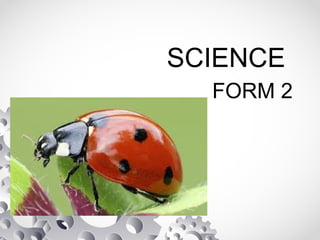
SCIENCE OF SENSES
- 2. CHAPTER 1 THE WORLD THROUGH OUR SENSES
- 3. 1.1 Sensory Organs Sensory organs, stimuli and senses a) Sensory organs : organs that detect stimuli. b) Stimuli : Any changes that occur in the surroundings which lead to respond. c) Senses: detectors used to find out the stimuli.
- 4. sense sensory organs stimuli detected touch skin touch, pressure, heat, cold, pain taste tongue taste smell nose smell sight eyes light hearing ears sound
- 5. d) HOTS Without sensory organs, we will not be able to know what is happening in our surroundings. So, we must take care of our sensory organs from injuries.
- 6. Responses to stimuli • response: a reaction • receptor: a structure that recognize a stimulus in the internal/ external environment of an organism. • nerve impulses: electrical messages produced by receptor. • effector: part of the body that carry out responses. Example: muscle and gland
- 7. Common pathway from the stimulus to response in humans
- 9. 1.2 Sense of touch The Skin - largest organ in the body.
- 11. The sensitivity of the skin • Different parts have different degrees of sensitivity. • Depends on: 1.how close together the receptors are - the higher the concentration of receptor, the more sensitive the skin is 2.how deep the receptor are - the thicker the epidermis, the deeper the receptors lie in the skin, the less sensitive the skin is.
- 12. Examples: • The back of the body is less sensitive as it has very few touch reseptor. • The knees and elbows are less sensitive as they have a thick epidermis. • The lips and fingertips are very sensitive to touch due to the large number of touch receptor. They have thin epidermis too.
- 13. HOTS- APPLICATION • Blind people use the high sensitivity of their fingertips to read in Braille. Raised dots are used to represent letters and numbers.
- 14. • Doctors give injections to their patients at the forearms or hips. One of the reasons for this is these areas are less sensitive to pain.
- 15. • The back of the hands has a lot of heat and cold receptors (temperature). Mother test the temperature of their babies' milk on the back of their hands.
- 17. 1.3 Sense of smell
- 18. 1.Two holes, called nostrils, open into a large hollow space called nasal cavity. 2.The nasal cavity is lined with mucus. Its roof has many smell receptors/ sensory cell. 3.Adaptation: The smell receptors are always covered with mucus. Smells must dissolve in the mucus before they can be detected.
- 19. • Smell receptors are located at the roof of the nasal cavity. This position allows the receptors to have the maximum exposure to the air current.
- 20. Detecting smell. • Smells are actually chemicals present in the air. • Food, perfume .............air. • When we breathe in, .........cavity. • The ......cells. • These ........smell. • After smelling ......brain. • Then we ....... smell it.
- 21. HOTS!!!!! • When a person catches a cold, they cannot detect smell well. The nose produces too much mucus which prevents chemicals from stimulating the smell receptors. • A dog's sense of smell is hundred times more sensitive than human. Therefore, dogs are being used to track criminals and to sniff out drugs or explosives.
- 23. 1.4 Sense of Taste • draw figure 1.8 pg 9
- 24. draw figure 1.9 pg 10
- 25. 1.Tongue is sensitive to chemicals in food that give taste to food. 2.Can detect 4 tastes: _____, _____, _____ and _______. 3.The tongue is lined with taste buds which contain many taste receptor.
- 26. How tastes are detected? • When we chew our ..................saliva. • The dissolved.......................impulses. • These are ................................tastes. pg 10
- 27. The senses of taste and smell. • Both senses are needed to detect the flavour of food/ drink accurately. • The nasal cavity and mouth are connected. When we eat/ drink, chemicals from food move up to nasal cavity and stimulate the smell receptors in the nose as well.
- 28. • When we have cold, chemicals in the food cannot reach the smell receptors because excessive mucus or blocked nose. So, the food become less tasty.
